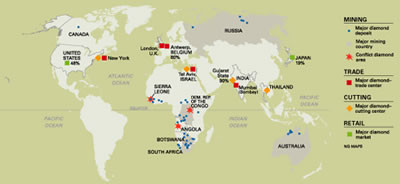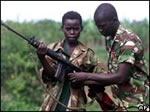 Blood diamonds got their start in 1992 in the bush war of Angola, where UNITA leader Jonas Savimbi, seeking new ways to finance his army, looked to the country’s vast diamond fields to extend the smuggling business that his rebel movement had pioneered in the 1970s and 1980s. By 1993, Savimbi had in place the world’s largest diamond smuggling network, netting hundreds of million dollars a year with which he bought arms. Among those companies dealing with Savimbi’s blood diamonds was the South African company, De Decker Diamonds, which admitted selling the blood diamonds directly to De Beers. De Beers has acknowledged doing business with De Decker, but has said it never knowingly bought diamonds from UNITA.
Blood diamonds got their start in 1992 in the bush war of Angola, where UNITA leader Jonas Savimbi, seeking new ways to finance his army, looked to the country’s vast diamond fields to extend the smuggling business that his rebel movement had pioneered in the 1970s and 1980s. By 1993, Savimbi had in place the world’s largest diamond smuggling network, netting hundreds of million dollars a year with which he bought arms. Among those companies dealing with Savimbi’s blood diamonds was the South African company, De Decker Diamonds, which admitted selling the blood diamonds directly to De Beers. De Beers has acknowledged doing business with De Decker, but has said it never knowingly bought diamonds from UNITA.
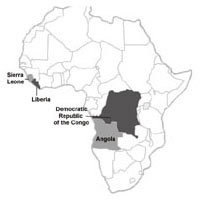 This pattern of using blood diamonds were used as war currency was replicated in other African conflicts, particularly in Sierra Leone, Liberia and the Democratic Republic of the Congo. But it was not until 1998, when the United Nations first began investigating conflict diamonds, that the issue grabbed the attention of the industry and diamond buyers and the public worldwide. Canada’s ambassador to the world body, Robert Fowler, oversaw in-depth conflict diamond The United Nations ultimately created a “monitoring mechanism” to investigate conflict diamond peddling in Angola, and the Security Council imposed sanctions on diamond dealing with UNITA in 1998 – a ban later expanded to Liberia and the rebel-held areas of Sierra Leone. But only a handful of countries enacted laws to implement the sanctions, and the only known prosecution for trading in blood diamonds is expected to begin in the coming months in Belgium.
This pattern of using blood diamonds were used as war currency was replicated in other African conflicts, particularly in Sierra Leone, Liberia and the Democratic Republic of the Congo. But it was not until 1998, when the United Nations first began investigating conflict diamonds, that the issue grabbed the attention of the industry and diamond buyers and the public worldwide. Canada’s ambassador to the world body, Robert Fowler, oversaw in-depth conflict diamond The United Nations ultimately created a “monitoring mechanism” to investigate conflict diamond peddling in Angola, and the Security Council imposed sanctions on diamond dealing with UNITA in 1998 – a ban later expanded to Liberia and the rebel-held areas of Sierra Leone. But only a handful of countries enacted laws to implement the sanctions, and the only known prosecution for trading in blood diamonds is expected to begin in the coming months in Belgium.
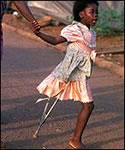 The rebels carried out one of the most brutal military campaigns in recent history, to enrich themselves as well as the heads of the diamond industry living far removed from the killing fields. The rebels’ signature tactic was amputation of civilians: Over the course of the decade-long war, the rebels in Sierra Leone alone have mutilated some 20,000 people, hacking off their arms, legs, lips, and ears with machetes and axes. Another 50,000 to 75,000 thousand have been killed related to the blood diamonds in Sierra Leone.
The rebels carried out one of the most brutal military campaigns in recent history, to enrich themselves as well as the heads of the diamond industry living far removed from the killing fields. The rebels’ signature tactic was amputation of civilians: Over the course of the decade-long war, the rebels in Sierra Leone alone have mutilated some 20,000 people, hacking off their arms, legs, lips, and ears with machetes and axes. Another 50,000 to 75,000 thousand have been killed related to the blood diamonds in Sierra Leone.
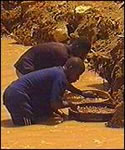 White the rebels terrorized and looted the countryside, thousands of prisoner-laborers, worked to exhaustion, digging up the blood diamonds from muddy open-pit mines. Many ended up in shallow graves, executed for suspected theft, for lack of production, or simply for sport.
White the rebels terrorized and looted the countryside, thousands of prisoner-laborers, worked to exhaustion, digging up the blood diamonds from muddy open-pit mines. Many ended up in shallow graves, executed for suspected theft, for lack of production, or simply for sport.
The blood diamond issue took on greater significance, however, after the Sept. 11, 2001, terrorist attacks on the United States, when media reports cited evidence that diamonds were used by terrorist organizations, including al Qaeda, as a means of transferring their wealth globally.
But, as the ICIJ investigation found, the ties to terrorist organizations go back even further. The diamond dealer identified in the European intelligence report is known in the industry for his association with Hezbollah, according to two diamond dealers who have worked closely with him but who would not speak on the record. The intelligence report also says that the dealer’s company has done business with the terrorist organization, and that the dealer is connected to a web of influential Lebanese families working in the Congo and West Africa that includes Imad Bakri. Bakri was identified in a 2000 U.N. report (under the name Imad Kebir) as a major supplier of weapons for UNITA.
Responding to the heightened attention on blood diamonds and seeking to protect their industry, southern African officials launched the Kimberley Process – a name recalling not only the birthplace of the country’s diamond industry but, ironically, the home of its latest controversy.
The process provides for an international framework in which to identify and record the origin of the world’s diamonds under the auspices of the diamond industry’s World Diamond Council, which includes senior De Beers’ executives. But even that process has been criticized. The General Accounting Office, the investigative arm of the U.S. Congress, said in a February 2002 report that the Kimberley Process was inherently flawed. The report said that the time period after rough diamonds enter the first foreign port until the final point of sale is covered by a system of voluntary industry participation and self-regulated monitoring and enforcement. These and other shortcomings provide significant challenges in creating an effective scheme to deter trade in blood diamonds.
De Beers (creator of the “a diamond is forever” marketing campaign) knows better than anyone that its industry depends heavily on perception. After initially being defensive about the issue of blood diamonds, De Beers came to see the advantage of it. With its monopolistic hold on the world supply of rough diamonds slipping by about 20 percent in recent years, here was a way of regaining control and decreasing the supply of diamonds, or at least socially acceptable ones. De Beers stopped buying diamonds on the open market (in Africa and in Antwerp, the world’s diamond trading capital) relying instead on its own mines and other countries where it has marketing joint ventures with local producers. It also strengthened the concept of “branded diamonds” by introducing stones engraved with the De Beers’ brand on special machinery developed in the United Kingdom guaranteeing, among other things, that the stones are conflict free.
Conflict diamonds were one of the greatest marketing tools ever invented by the diamond industry. DeBeers has dismissed any suggestion that it is actively promoting the campaign against conflict diamonds. But, asked in December 2000 whether the conflict diamonds issue had turned out to be a blessing in disguise, De Beers chief executive Gary Ralfe replied, “Absolutely,” adding that the company hoped to eliminate conflict diamonds. De Beers has taken several steps to reduce, if not eliminate, its exposure to blood diamonds.
Apart from hiding the fact that they have halted their open market buying operations in Africa and in Antwerp, De Beers has created an illusion that they have stopped buying stones from official government mines in African countries, such as the Congo. Unless such operations can guarantee that no blood diamonds from rebel areas leak into the system (a guarantee that is impossible to give in most cases) De Beers says it cannot take the risk.
But given its dominance in the diamond field, some question whether De Beers has been as untouched by conflict diamonds as it has claimed or whether there aren’t blood diamonds in its vast vault of stones. De Beers’ tentacles stretch into most corners of the diamond industry, and it bought diamonds from rebels in Angola until the 1998 U.N. sanctions took effect.
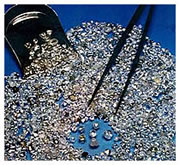 In addition, De Beers’ opaque operating procedures make it impossible to trace the origin of its diamonds. For example, the company mixes its collection of stones, making it nearly impossible to determine their origin. All the stones De Beers purchases are combined at the company’s offices in central London before being sorted into 16,000 categories for its sightholders to examine. De Beers’ system is based on the mixing of all supplies into one production for sale.
In addition, De Beers’ opaque operating procedures make it impossible to trace the origin of its diamonds. For example, the company mixes its collection of stones, making it nearly impossible to determine their origin. All the stones De Beers purchases are combined at the company’s offices in central London before being sorted into 16,000 categories for its sightholders to examine. De Beers’ system is based on the mixing of all supplies into one production for sale.
De Beers has long given the perception that it exercises considerable control in the African countries in which it operates. The government of Botswana is often jokingly referred to as a division of De Beers, and in both South Africa and Namibia, De Beers has had close relationships with the government. Since the blood diamonds debacle began, this reputation for control has ironically obliged De Beers to seek to underplay the company’s strength or ability to peddle influence.
De Beers’ position on blood diamonds is further complicated by the company’s intimate relationship with its sightholders, who receive their allotments of diamonds from De Beers in London. The system allows De Beers to reward favored sightholders with what are called “special stones.” These windfalls can dramatically affect a sightholder’s fortunes.
The De Beers monopoly hinges on influence, knowledge and trust, and the sightholder network is a crucial part of this axis. Favoritism also plays a role. Benny Steinmetz, an Israeli diamond dealer, is now widely seen as De Beers’ king among sightholders, according to industry insiders. He has historically been an important presence for the company in Angola and is believed to be involved in the company’s plans to return there now that war has ended.
Sightholders of Steinmetz’s caliber get to be part of the club, in part, because they use their political influence to look after the interests of the company. All of which means that De Beers is exposed to any indiscretions on the part of its sightholders, such as the European dealer with alleged ties to Hezbollah and conflict diamonds, named in the intelligence report. One of De Beers’ problems is that its methods of control have bound it to so many players in the diamond industry that it has to keep an eye on what all these players are up to where suspect diamonds are concerned. If, for example, there was any action taken against the sightholder trading at Kimberley, De Beers would be exposed and have to take action itself. The company has tied its sightholders to an ethical pledge, which precludes trading in blood diamonds.
Here are a couple of popular books about blood diamonds.
Blood Diamonds: Tracing the Deadly Path of the World’s Most Precious Stones
by Greg Campbell
 Journalist Greg Campbell leads the reader down the international diamond trail of brutality, horror, and profit – providing an on-the-ground and in-the-mines story of global consequence.
Journalist Greg Campbell leads the reader down the international diamond trail of brutality, horror, and profit – providing an on-the-ground and in-the-mines story of global consequence.
First discovered in 1930, the diamonds of Sierra Leone have funded one of the most savage rebel campaigns in modern history. These “blood diamonds” are smuggled out of West Africa and sold to legitimate diamond merchants in London, Antwerp, and New York, often with the complicity of the international diamond industry. Eventually, these very diamonds find their way into the rings and necklaces of brides and spouses the world over. Blood Diamonds is the gripping tale of how the diamond smuggling works, how the rebel war has effectively destroyed Sierra Leone and its people, and how the policies of the diamond industry – institutionalized in the 1880s by the De Beers cartel – have allowed it to happen. Award-winning journalist Greg Campbell traces the deadly trail of these diamonds, many of which are brought to the world market by fanatical enemies, including the Al Qaeda network. These repercussions of diamond smuggling are felt far beyond the borders of the poor and war-ridden country of Sierra Leone, and the consequences of overlooking this African tragedy, as the world has seen, are both shockingly deadly and unquestionably global.
Blood Diamonds
by Jon Land
 The West African country of Sierra Leone has long been known as a diamond-rich area. With civil war ripping the heart out of the country, all aspects of life there are unstable. Worst of all, guerrilla rebels, in their lust for the resource-rich land, have sunk to depravity and terrorism to evict people from the country.
The West African country of Sierra Leone has long been known as a diamond-rich area. With civil war ripping the heart out of the country, all aspects of life there are unstable. Worst of all, guerrilla rebels, in their lust for the resource-rich land, have sunk to depravity and terrorism to evict people from the country.
It’s into this maelstrom of political and emotional turmoil that Ben and Danielle must go. The leader of the rebels, a fanatical and charismatic woman known only as the Dragon, is not content with ravaging her own country. She plans a final coup that will perfect her power and topple Western governments-unless Ben and Danielle can stop her in time.

